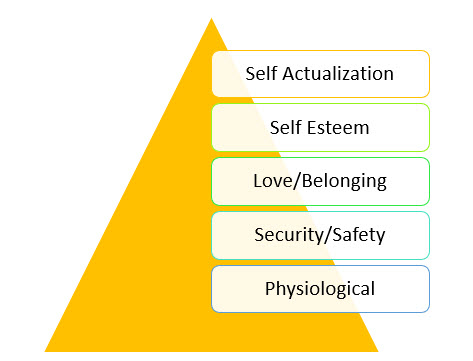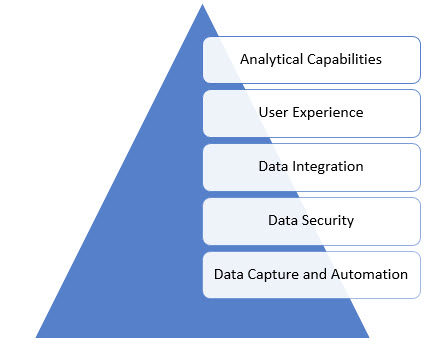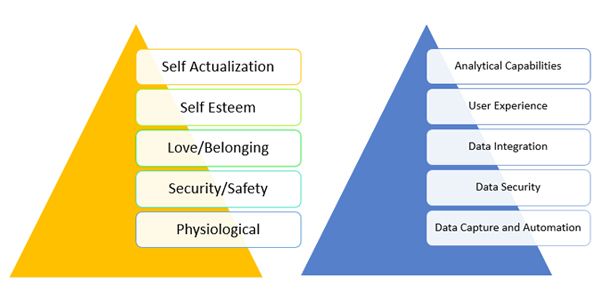Applying Maslow’s theory of Needs to Business Analysis
Having worked on multiple IT implementations and Transformation projects I have often found the evolution of user’s requirements follow the Maslow’s theory of needs.
Adoption of this theory in the requirement gathering process would turn out be fruitful for Business Analysts in efficient Requirement Elicitation from the Users.
Although most of us are aware about the Maslow’s Theory of needs, a quick memory refresh would be helpful:
Maslow’s hierarchy of needs displays the order of human needs in the form of a Pyramid with lowest levels made up of most basic needs moving on to the top of the pyramid with complex needs as depicted below.

Physiological Needs: The basic human requirements to survive would comprise the Physiological needs like Food, Water, warmth, and rest.
Security/Safety: Once the Physiological needs are satisfied, the need for security and safety arises. This comprises of financial, emotional, social security, and health and well-being.
Love/Belonging: These needs are driven by interpersonal relations like friendship, love, trust and acceptance among individuals.
Self-Esteem: The fourth level of needs arise out of the feelings of getting praised by others for self-accomplishments be it professional, academic, athletic, or personal.
Self-Actualization: The final level of needs reflects the realization of individuals to utilize the complete potential, so that they can do the best that they are capable of doing.
Now coming back to our original discussion on following the Maslow’s theory of needs for requirements elicitation, the below framework often works to elicit requirements from users starting from basic system requirements to the complex analytical requirements to explore the full potential of the system.

The 5 evolving stages of requirements are Data Capture, Data Security, System Integration, User Experience, and Analytical Capabilities. As we progress from bottom to top of the pyramid, the responsibility of BA to make recommendations to elicit the requirements from the users increases. Let us look at each of these stages by taking an example of a Salesforce CRM implementation
1. Data Capture:
The first stage is critical and forms the major portion of requirements as this serves as the foundation of the implementation just like the Physiological needs serve as the base for human survival.
In general, any IT implementation would start with a problem statement where the Business has an issue with missing data capture or users spending their valuable time on mundane repetitive tasks which could be automated. It is the responsibility of the Business Analyst to capture the basic needs from users in terms of data they would like to capture, and the level of automation required to perform their everyday job.
In our example of Salesforce implementation, the information that needs to be captured like Leads, Opportunities, Accounts, Contacts need to be captured at parameter level with respective UI forms for data capture along with validations. Also, the automations that govern the system functionality need to be captured. For example, updating a parameter in Accounts from the corresponding parameter on Contact.
2. Data Security:
Once the basic requirements are established with respect to Data storage, User Interface and automations, the security of the data recorded in the system becomes critical just like need for Security in human life.
Different sets of users would need access to different data elements and the level of access in terms of Read/Write would differ as well. The BA needs to carefully gather the requirements of Data Security from users and work on profiling of these users.
In our example of Salesforce implementation, the Sales team would needs read/write access on Opportunity data whereas the Finance team would only need read access to Opportunities to perform forecasting and the Operations team might not need access to Opportunity data at all. There would also be scenario when one Sales Representative would not want other Sales Representative to access his Opportunity data. Hence, the Security of the data forms the next level of User needs in order to feel secure while using the application.
3. Data Integration:
Once the data is recorded in the system and is secure within the system, the next need is to have communication with other systems so that there is proper exchange of information between the systems to complete the end to end transactions. This is like the need for interpersonal relations like friendship between humans.
Different systems serve as the system of record for different data elements within an IT Architecture. Also, in most cases there is always a Master data system where all the critical data gets stored. As a BA it is important to identify the need for the required data for an application to work as expected and identify the downstream systems which would use the data from the application. This information may not be directly provided by the end users, but it is the responsibility of the BA to study the IT landscape and identify the different source and destinations of data.
In our case of Salesforce implementation, the Customer Account information would generally be recorded in the ERP, so Salesforce needs to integrate with the ERP to get the Account information. The Order information from Salesforce was used by downstream order fulfillment application, so Salesforce needs to integrate with this downstream application to complete the Order fulfilment process.
4. User Experience:
Once a working system is in place with the required basic functionalities to fulfill everyday job of the user, the user experience factor comes in which would further drive the requirements to make the system more user friendly and intuitive, hence leading to appreciation of the system by the users. This is like the self-esteem needs of human life.
Now that the basic functional requirements from the user are gathered, it is the responsibility of the BA to drive the requirements for better user experience. This would encompass aesthetic requirements like the look and feel of screens, user guidance while using the system, mobile usability etc. Although this type of requirements might not sound critical during the initial implementations, they turn out to be critical once the users start using the system, and there have been projects purely focusing on improving user experience.
In our case of Salesforce implementation, the choice between using Salesforce classic which is traditional user interface as compared to Salesforce Lightning which has an advanced User Interface would be critical in determining the user experience.
5. Analytical Capabilities:
Once the requirements for a fully functional and user friendly system are established, the insights that the data stored in the system could provide to the user becomes important, as it would enable the user to utilize the complete potential of the system and make business decisions. This is like the need for realization of individuals to utilize the complete potential so that they can do the best that they are capable of doing.
The Analytical requirements would be predominantly in the form of Reports and Dashboards that could be derived from the data stored in a system. With the advancement in Artificial Intelligence, the data could be used to provide suggestions to the user as well. Many a times, the user may not be directly able to give requirements with respect to Analytical capabilities, so the BA needs to determine the KPIs for the business users and recommend the suitable reports and dashboards around the same.
In our case of Salesforce implementation, once the Sales users have a well-functioning Opportunities module in Salesforce, it would be great if they are able to generate reports on the Opportunity pipeline and even better if they have a dashboard depicting the Opportunity Pipeline which would enable them to make quick decisions.
Requirement elicitation is often complex with users not being able to articulate the exact requirements in a proper order. Following the bottom-up approach from the Pyramid would help to a great extent in eliciting the requirements from users, starting from basic to the complex requirements.
